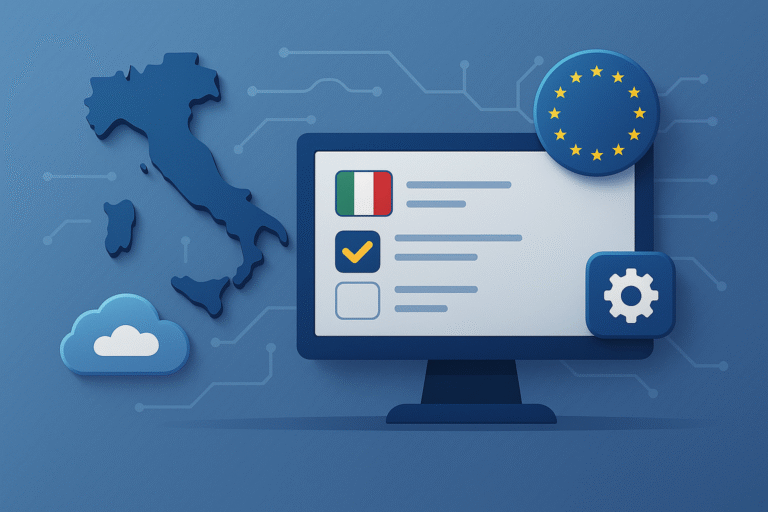
Introduction
More and more local communities, associations, condominiums, and even public institutions are adopting digital tools to foster dialogue and collective decision-making. However, choosing the right platform is not an easy task.
There are many solutions available on the market: forums, online voting systems, participatory budgeting platforms, collaborative tools based on blockchain or artificial intelligence. But what criteria should be considered to identify the most suitable one for your community?
This article explores the key factors to consider when making a conscious choice, avoiding mistakes that could undermine the success of the initiative.
1. Define the community’s objectives
The first step is to clarify what the community’s objectives are.
- Is the goal to promote dialogue and idea sharing?
- Is the purpose to collect proposals and vote on them democratically?
- Or is the objective to build a structured deliberative process?
Without a clear vision, there is a risk of choosing a platform that is either too complex or too limited. As highlighted in What is digital democracy and why it matters today, clarity of objectives is the prerequisite for effective participation.
2. Usability and accessibility
The platform must be easy to use for all community members, including those with limited digital skills.
Key elements to evaluate:
- intuitive and multilingual interface,
- compatibility with mobile devices,
- accessibility for people with disabilities,
- simple registration and login processes.
The experience of digital democracy in Finland shows how ease of use can determine the success or failure of an initiative.
3. Security and data protection
Citizen trust depends on security.
A reliable platform must:
- comply with GDPR and protect personal data,
- ensure transparency in voting procedures,
- offer secure authentication systems,
- provide audit trails and certifications when necessary.
In the case of online voting, experiences such as Estonia show that without robust systems, the legitimacy of the process can be questioned.
4. Flexibility and scalability
A platform should be able to grow with the community.
Initially, a simple forum may be enough, but over time more advanced tools may be needed, such as:
- certified voting systems,
- participatory budgeting modules,
- advanced moderation features,
- integration with chatbots (Chatbots and civic participation: what changes).
The best choice is therefore a flexible and scalable platform that can adapt to future needs.
5. Transparency and traceability
A participatory process must be transparent: every contribution should be visible and traceable, so that citizens can verify how their ideas are considered.
Transparency is what distinguishes a genuine digital democracy platform from a simple online survey. Without traceability, trust in the platform is quickly compromised.
6. Costs and sustainability
Every community has a limited budget. It is important to evaluate:
- license or subscription fees,
- maintenance and update costs,
- availability of technical support.
Some open-source platforms can reduce costs but require internal management skills. Others provide turnkey services, easier to use but more expensive. The decision should consider not only the immediate cost but also long-term sustainability.
7. Moderation and quality of debate
A good tool is useless without careful debate management.
As pointed out in Mistakes to avoid in online participation, the lack of moderation leads to conflict, spam, and loss of credibility.
The ideal platform should include features such as:
- reporting inappropriate content,
- clear behavioral guidelines,
- support for moderators (notifications, synthesis tools).
8. Integration with other tools
Another key factor is the ability to integrate the platform with:
- newsletter and communication systems,
- social networks,
- data analysis tools,
- mobile applications.
This makes it easier to reach more people and to analyze the results of the participatory process.
Reflections for Concorder
The Concorder project fits into this vision: offering a complete, secure, and transparent platform designed for communities of all sizes.
Concorder already integrates tools for:
- secure online voting,
- proposal management,
- debate moderation,
- transparency through audit trails.
In the future, the platform could be enriched with advanced features such as chatbot integration and AI-powered automatic synthesis of contributions.
Conclusion
Choosing the right platform for your community means balancing needs, resources, and objectives.
Technology offers extraordinary opportunities, but only a conscious choice can turn them into successful participatory processes.
Clear objectives, ease of use, security, transparency, and economic sustainability are the pillars on which to base the decision.
Looking at international best practices, such as those of Finland and Estonia, and emerging tools like Concorder, can help communities make more informed decisions and build strong, inclusive participatory processes.


